Data and System Integration
VerifiedAdded on 2023/06/14
|14
|2990
|408
AI Summary
This report discusses the use of Enterprise Information Architecture Reference Architecture approach to develop a national EHR system. It covers conceptual, logical and component architecture along with benefits and capabilities of the system.
Contribute Materials
Your contribution can guide someone’s learning journey. Share your
documents today.

Running Head: DATA AND SYSTEM INTEGRATION
Data and System Integration
[Name of the Student]
[Name of the University]
[Author note]
Data and System Integration
[Name of the Student]
[Name of the University]
[Author note]
Secure Best Marks with AI Grader
Need help grading? Try our AI Grader for instant feedback on your assignments.
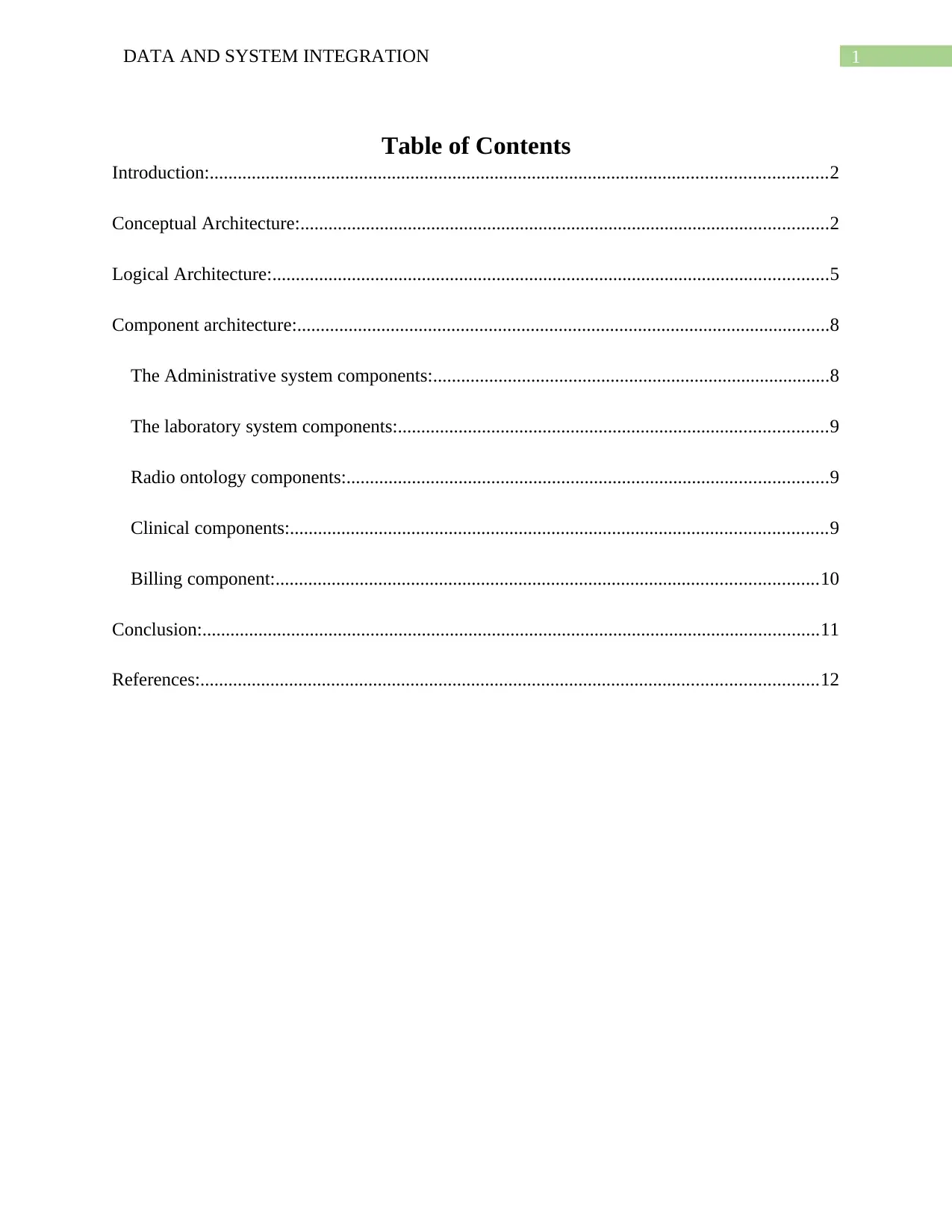
1DATA AND SYSTEM INTEGRATION
Table of Contents
Introduction:....................................................................................................................................2
Conceptual Architecture:.................................................................................................................2
Logical Architecture:.......................................................................................................................5
Component architecture:..................................................................................................................8
The Administrative system components:.....................................................................................8
The laboratory system components:............................................................................................9
Radio ontology components:.......................................................................................................9
Clinical components:...................................................................................................................9
Billing component:....................................................................................................................10
Conclusion:....................................................................................................................................11
References:....................................................................................................................................12
Table of Contents
Introduction:....................................................................................................................................2
Conceptual Architecture:.................................................................................................................2
Logical Architecture:.......................................................................................................................5
Component architecture:..................................................................................................................8
The Administrative system components:.....................................................................................8
The laboratory system components:............................................................................................9
Radio ontology components:.......................................................................................................9
Clinical components:...................................................................................................................9
Billing component:....................................................................................................................10
Conclusion:....................................................................................................................................11
References:....................................................................................................................................12
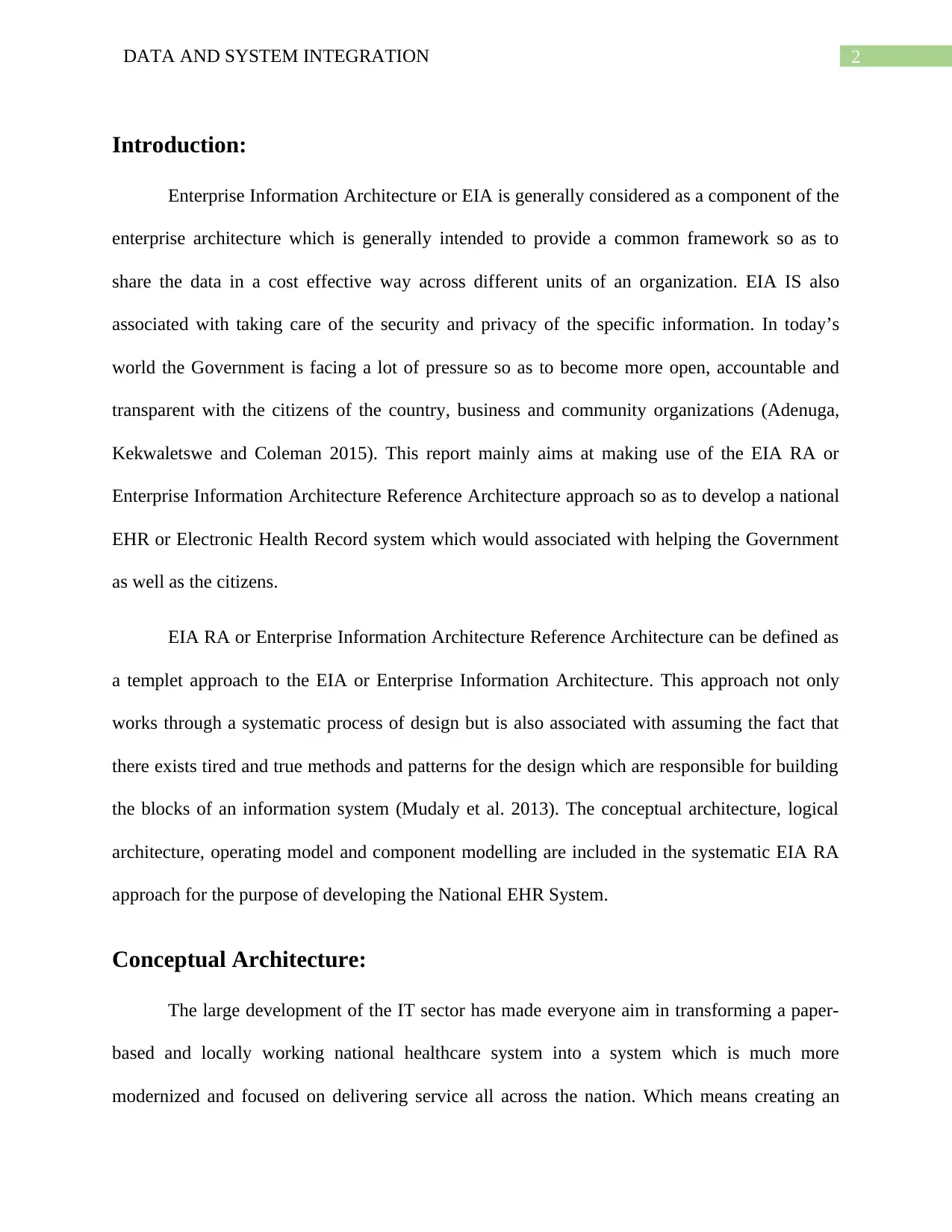
2DATA AND SYSTEM INTEGRATION
Introduction:
Enterprise Information Architecture or EIA is generally considered as a component of the
enterprise architecture which is generally intended to provide a common framework so as to
share the data in a cost effective way across different units of an organization. EIA IS also
associated with taking care of the security and privacy of the specific information. In today’s
world the Government is facing a lot of pressure so as to become more open, accountable and
transparent with the citizens of the country, business and community organizations (Adenuga,
Kekwaletswe and Coleman 2015). This report mainly aims at making use of the EIA RA or
Enterprise Information Architecture Reference Architecture approach so as to develop a national
EHR or Electronic Health Record system which would associated with helping the Government
as well as the citizens.
EIA RA or Enterprise Information Architecture Reference Architecture can be defined as
a templet approach to the EIA or Enterprise Information Architecture. This approach not only
works through a systematic process of design but is also associated with assuming the fact that
there exists tired and true methods and patterns for the design which are responsible for building
the blocks of an information system (Mudaly et al. 2013). The conceptual architecture, logical
architecture, operating model and component modelling are included in the systematic EIA RA
approach for the purpose of developing the National EHR System.
Conceptual Architecture:
The large development of the IT sector has made everyone aim in transforming a paper-
based and locally working national healthcare system into a system which is much more
modernized and focused on delivering service all across the nation. Which means creating an
Introduction:
Enterprise Information Architecture or EIA is generally considered as a component of the
enterprise architecture which is generally intended to provide a common framework so as to
share the data in a cost effective way across different units of an organization. EIA IS also
associated with taking care of the security and privacy of the specific information. In today’s
world the Government is facing a lot of pressure so as to become more open, accountable and
transparent with the citizens of the country, business and community organizations (Adenuga,
Kekwaletswe and Coleman 2015). This report mainly aims at making use of the EIA RA or
Enterprise Information Architecture Reference Architecture approach so as to develop a national
EHR or Electronic Health Record system which would associated with helping the Government
as well as the citizens.
EIA RA or Enterprise Information Architecture Reference Architecture can be defined as
a templet approach to the EIA or Enterprise Information Architecture. This approach not only
works through a systematic process of design but is also associated with assuming the fact that
there exists tired and true methods and patterns for the design which are responsible for building
the blocks of an information system (Mudaly et al. 2013). The conceptual architecture, logical
architecture, operating model and component modelling are included in the systematic EIA RA
approach for the purpose of developing the National EHR System.
Conceptual Architecture:
The large development of the IT sector has made everyone aim in transforming a paper-
based and locally working national healthcare system into a system which is much more
modernized and focused on delivering service all across the nation. Which means creating an
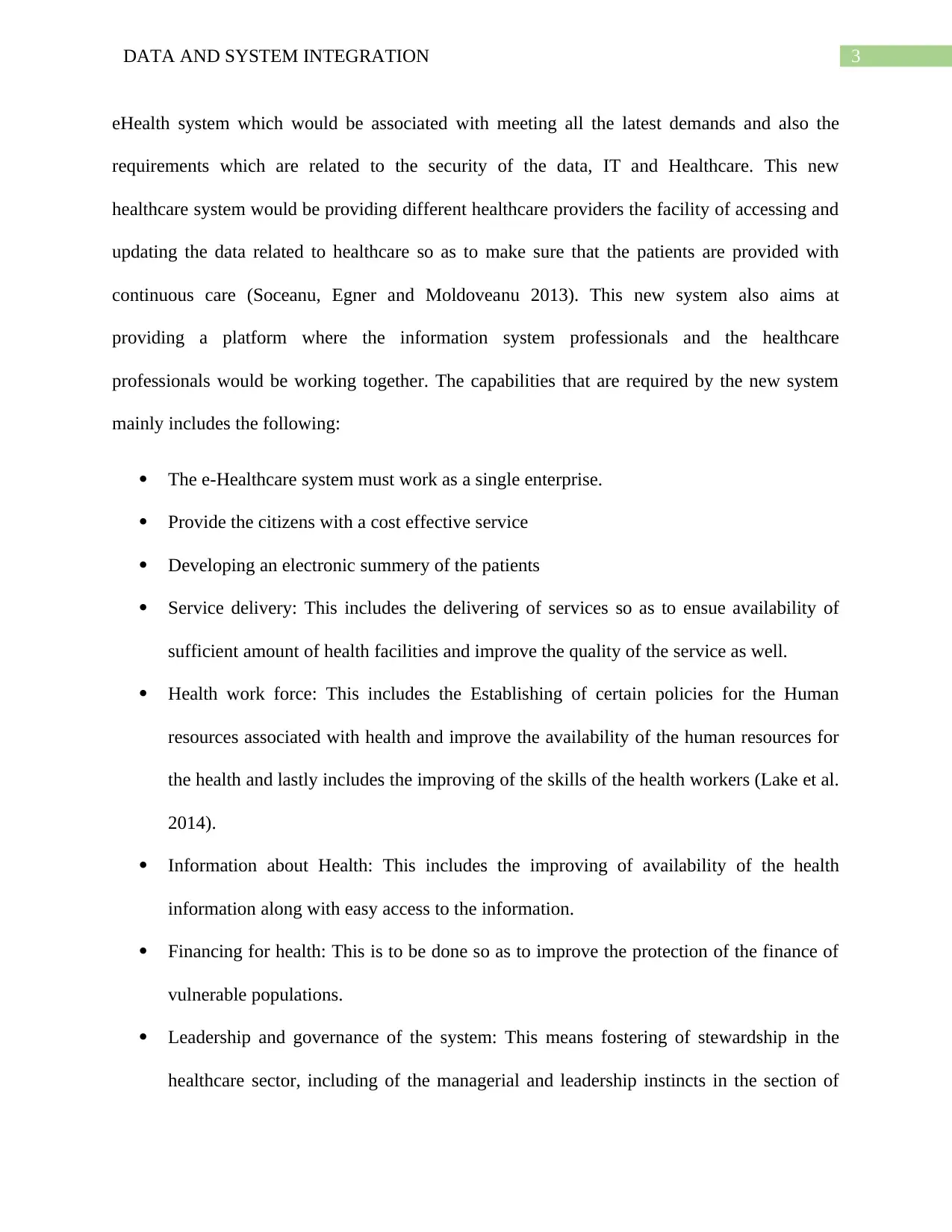
3DATA AND SYSTEM INTEGRATION
eHealth system which would be associated with meeting all the latest demands and also the
requirements which are related to the security of the data, IT and Healthcare. This new
healthcare system would be providing different healthcare providers the facility of accessing and
updating the data related to healthcare so as to make sure that the patients are provided with
continuous care (Soceanu, Egner and Moldoveanu 2013). This new system also aims at
providing a platform where the information system professionals and the healthcare
professionals would be working together. The capabilities that are required by the new system
mainly includes the following:
The e-Healthcare system must work as a single enterprise.
Provide the citizens with a cost effective service
Developing an electronic summery of the patients
Service delivery: This includes the delivering of services so as to ensue availability of
sufficient amount of health facilities and improve the quality of the service as well.
Health work force: This includes the Establishing of certain policies for the Human
resources associated with health and improve the availability of the human resources for
the health and lastly includes the improving of the skills of the health workers (Lake et al.
2014).
Information about Health: This includes the improving of availability of the health
information along with easy access to the information.
Financing for health: This is to be done so as to improve the protection of the finance of
vulnerable populations.
Leadership and governance of the system: This means fostering of stewardship in the
healthcare sector, including of the managerial and leadership instincts in the section of
eHealth system which would be associated with meeting all the latest demands and also the
requirements which are related to the security of the data, IT and Healthcare. This new
healthcare system would be providing different healthcare providers the facility of accessing and
updating the data related to healthcare so as to make sure that the patients are provided with
continuous care (Soceanu, Egner and Moldoveanu 2013). This new system also aims at
providing a platform where the information system professionals and the healthcare
professionals would be working together. The capabilities that are required by the new system
mainly includes the following:
The e-Healthcare system must work as a single enterprise.
Provide the citizens with a cost effective service
Developing an electronic summery of the patients
Service delivery: This includes the delivering of services so as to ensue availability of
sufficient amount of health facilities and improve the quality of the service as well.
Health work force: This includes the Establishing of certain policies for the Human
resources associated with health and improve the availability of the human resources for
the health and lastly includes the improving of the skills of the health workers (Lake et al.
2014).
Information about Health: This includes the improving of availability of the health
information along with easy access to the information.
Financing for health: This is to be done so as to improve the protection of the finance of
vulnerable populations.
Leadership and governance of the system: This means fostering of stewardship in the
healthcare sector, including of the managerial and leadership instincts in the section of
Secure Best Marks with AI Grader
Need help grading? Try our AI Grader for instant feedback on your assignments.
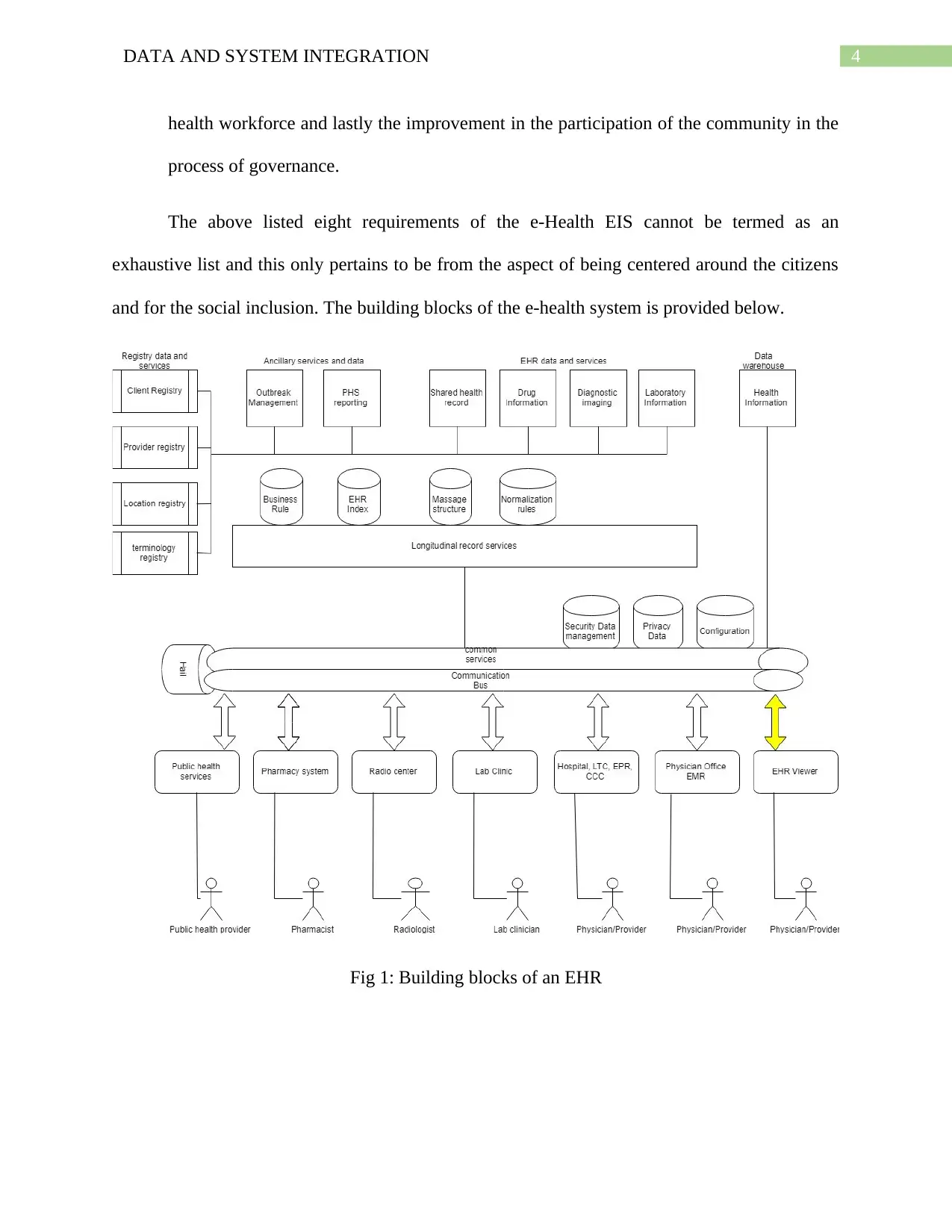
4DATA AND SYSTEM INTEGRATION
health workforce and lastly the improvement in the participation of the community in the
process of governance.
The above listed eight requirements of the e-Health EIS cannot be termed as an
exhaustive list and this only pertains to be from the aspect of being centered around the citizens
and for the social inclusion. The building blocks of the e-health system is provided below.
Fig 1: Building blocks of an EHR
health workforce and lastly the improvement in the participation of the community in the
process of governance.
The above listed eight requirements of the e-Health EIS cannot be termed as an
exhaustive list and this only pertains to be from the aspect of being centered around the citizens
and for the social inclusion. The building blocks of the e-health system is provided below.
Fig 1: Building blocks of an EHR
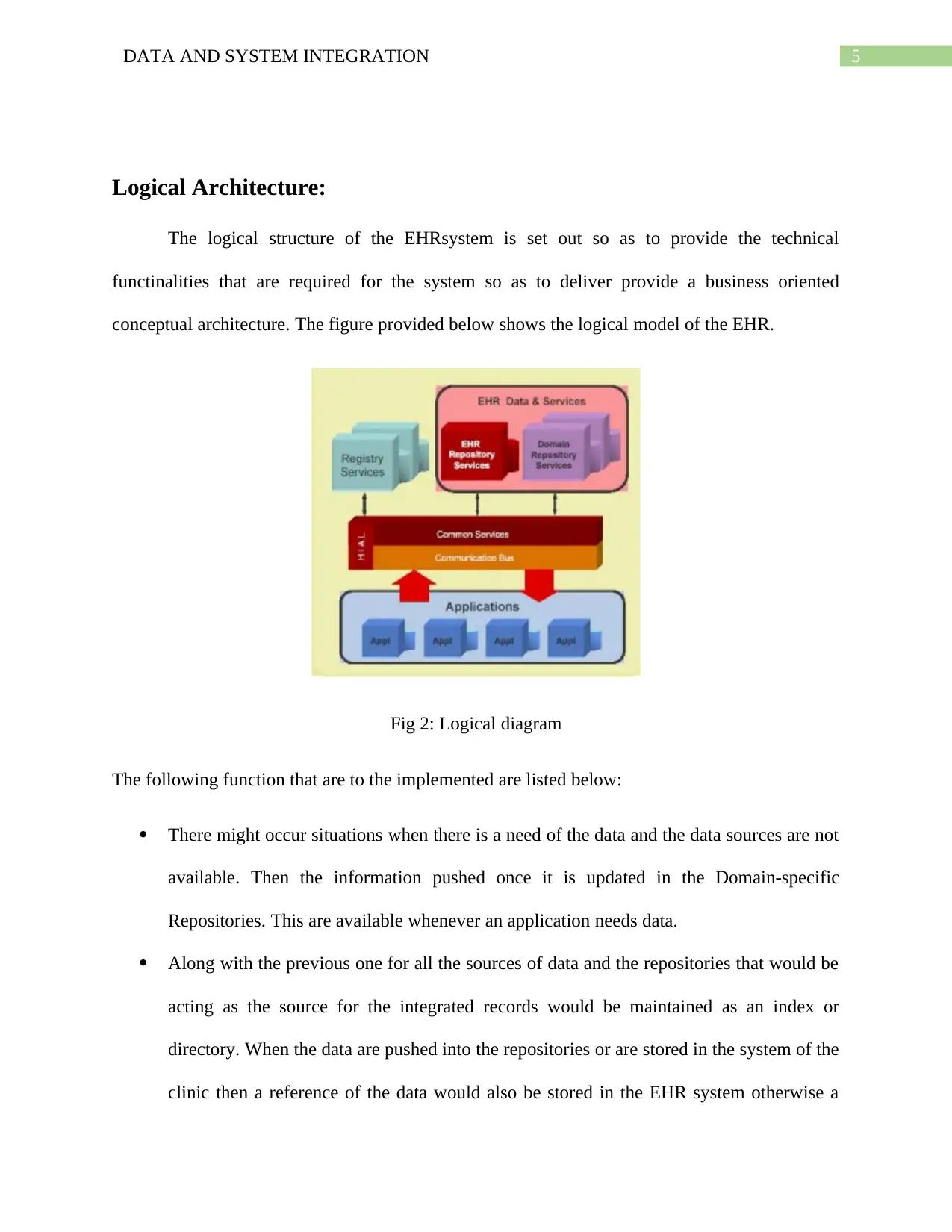
5DATA AND SYSTEM INTEGRATION
Logical Architecture:
The logical structure of the EHRsystem is set out so as to provide the technical
functinalities that are required for the system so as to deliver provide a business oriented
conceptual architecture. The figure provided below shows the logical model of the EHR.
Fig 2: Logical diagram
The following function that are to the implemented are listed below:
There might occur situations when there is a need of the data and the data sources are not
available. Then the information pushed once it is updated in the Domain-specific
Repositories. This are available whenever an application needs data.
Along with the previous one for all the sources of data and the repositories that would be
acting as the source for the integrated records would be maintained as an index or
directory. When the data are pushed into the repositories or are stored in the system of the
clinic then a reference of the data would also be stored in the EHR system otherwise a
Logical Architecture:
The logical structure of the EHRsystem is set out so as to provide the technical
functinalities that are required for the system so as to deliver provide a business oriented
conceptual architecture. The figure provided below shows the logical model of the EHR.
Fig 2: Logical diagram
The following function that are to the implemented are listed below:
There might occur situations when there is a need of the data and the data sources are not
available. Then the information pushed once it is updated in the Domain-specific
Repositories. This are available whenever an application needs data.
Along with the previous one for all the sources of data and the repositories that would be
acting as the source for the integrated records would be maintained as an index or
directory. When the data are pushed into the repositories or are stored in the system of the
clinic then a reference of the data would also be stored in the EHR system otherwise a
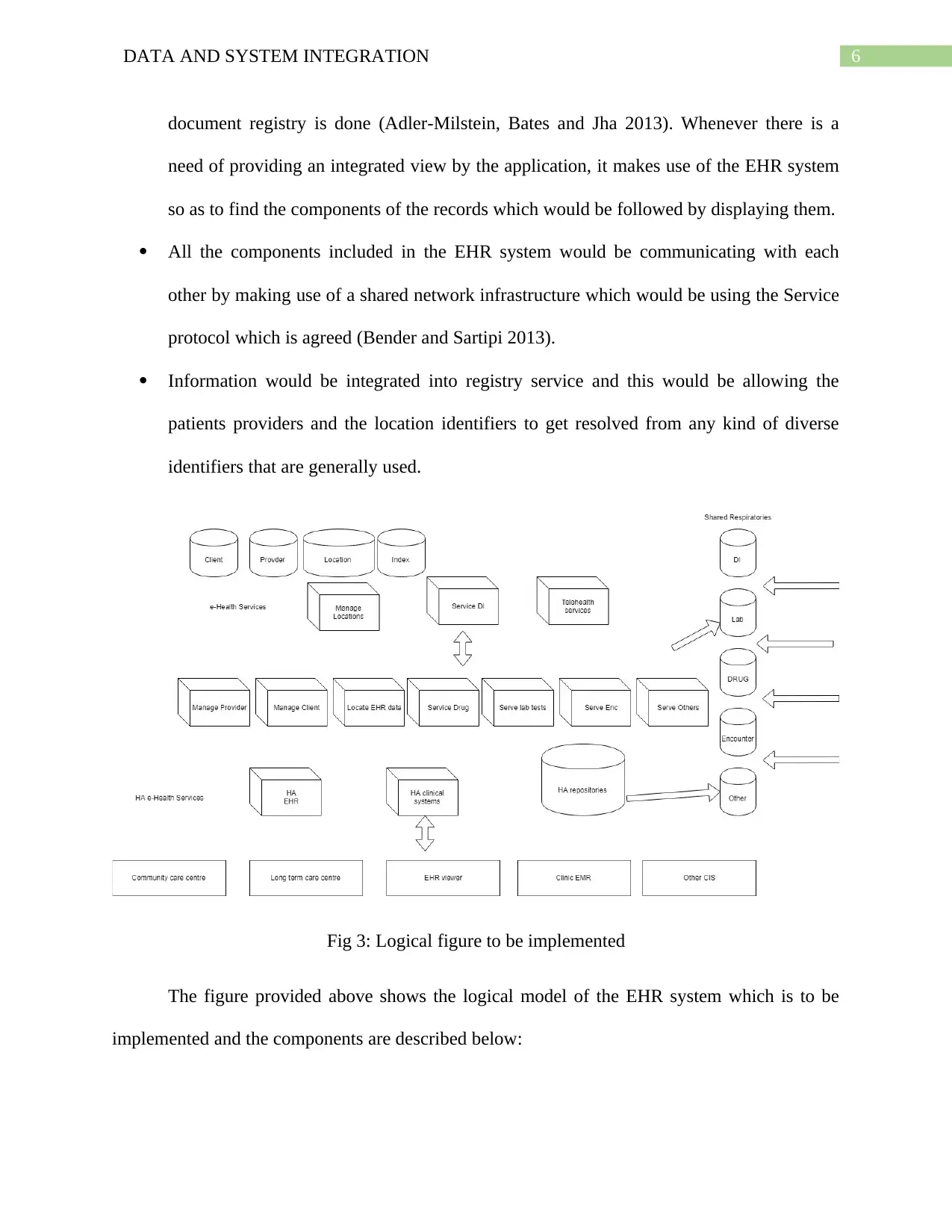
6DATA AND SYSTEM INTEGRATION
document registry is done (Adler-Milstein, Bates and Jha 2013). Whenever there is a
need of providing an integrated view by the application, it makes use of the EHR system
so as to find the components of the records which would be followed by displaying them.
All the components included in the EHR system would be communicating with each
other by making use of a shared network infrastructure which would be using the Service
protocol which is agreed (Bender and Sartipi 2013).
Information would be integrated into registry service and this would be allowing the
patients providers and the location identifiers to get resolved from any kind of diverse
identifiers that are generally used.
Fig 3: Logical figure to be implemented
The figure provided above shows the logical model of the EHR system which is to be
implemented and the components are described below:
document registry is done (Adler-Milstein, Bates and Jha 2013). Whenever there is a
need of providing an integrated view by the application, it makes use of the EHR system
so as to find the components of the records which would be followed by displaying them.
All the components included in the EHR system would be communicating with each
other by making use of a shared network infrastructure which would be using the Service
protocol which is agreed (Bender and Sartipi 2013).
Information would be integrated into registry service and this would be allowing the
patients providers and the location identifiers to get resolved from any kind of diverse
identifiers that are generally used.
Fig 3: Logical figure to be implemented
The figure provided above shows the logical model of the EHR system which is to be
implemented and the components are described below:
Paraphrase This Document
Need a fresh take? Get an instant paraphrase of this document with our AI Paraphraser
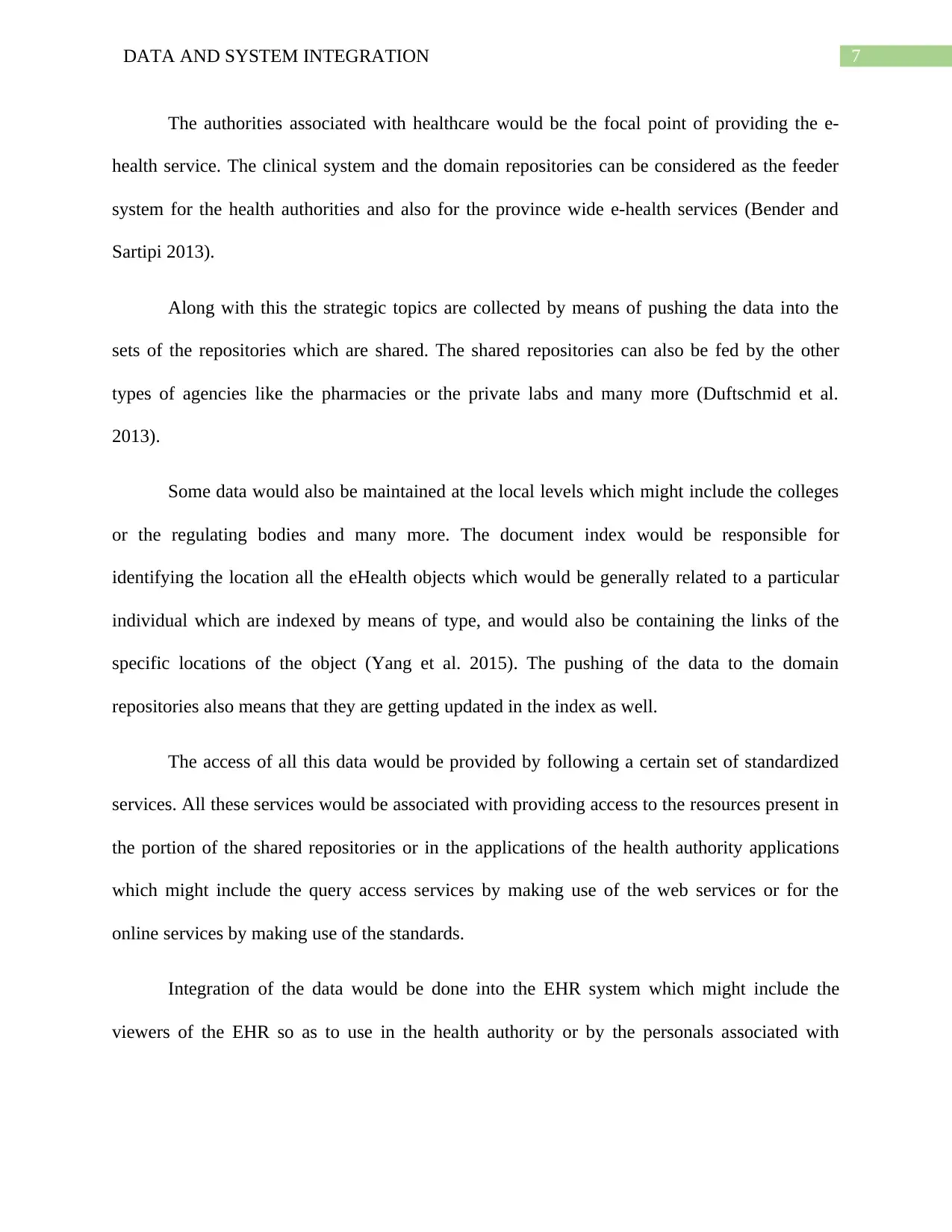
7DATA AND SYSTEM INTEGRATION
The authorities associated with healthcare would be the focal point of providing the e-
health service. The clinical system and the domain repositories can be considered as the feeder
system for the health authorities and also for the province wide e-health services (Bender and
Sartipi 2013).
Along with this the strategic topics are collected by means of pushing the data into the
sets of the repositories which are shared. The shared repositories can also be fed by the other
types of agencies like the pharmacies or the private labs and many more (Duftschmid et al.
2013).
Some data would also be maintained at the local levels which might include the colleges
or the regulating bodies and many more. The document index would be responsible for
identifying the location all the eHealth objects which would be generally related to a particular
individual which are indexed by means of type, and would also be containing the links of the
specific locations of the object (Yang et al. 2015). The pushing of the data to the domain
repositories also means that they are getting updated in the index as well.
The access of all this data would be provided by following a certain set of standardized
services. All these services would be associated with providing access to the resources present in
the portion of the shared repositories or in the applications of the health authority applications
which might include the query access services by making use of the web services or for the
online services by making use of the standards.
Integration of the data would be done into the EHR system which might include the
viewers of the EHR so as to use in the health authority or by the personals associated with
The authorities associated with healthcare would be the focal point of providing the e-
health service. The clinical system and the domain repositories can be considered as the feeder
system for the health authorities and also for the province wide e-health services (Bender and
Sartipi 2013).
Along with this the strategic topics are collected by means of pushing the data into the
sets of the repositories which are shared. The shared repositories can also be fed by the other
types of agencies like the pharmacies or the private labs and many more (Duftschmid et al.
2013).
Some data would also be maintained at the local levels which might include the colleges
or the regulating bodies and many more. The document index would be responsible for
identifying the location all the eHealth objects which would be generally related to a particular
individual which are indexed by means of type, and would also be containing the links of the
specific locations of the object (Yang et al. 2015). The pushing of the data to the domain
repositories also means that they are getting updated in the index as well.
The access of all this data would be provided by following a certain set of standardized
services. All these services would be associated with providing access to the resources present in
the portion of the shared repositories or in the applications of the health authority applications
which might include the query access services by making use of the web services or for the
online services by making use of the standards.
Integration of the data would be done into the EHR system which might include the
viewers of the EHR so as to use in the health authority or by the personals associated with
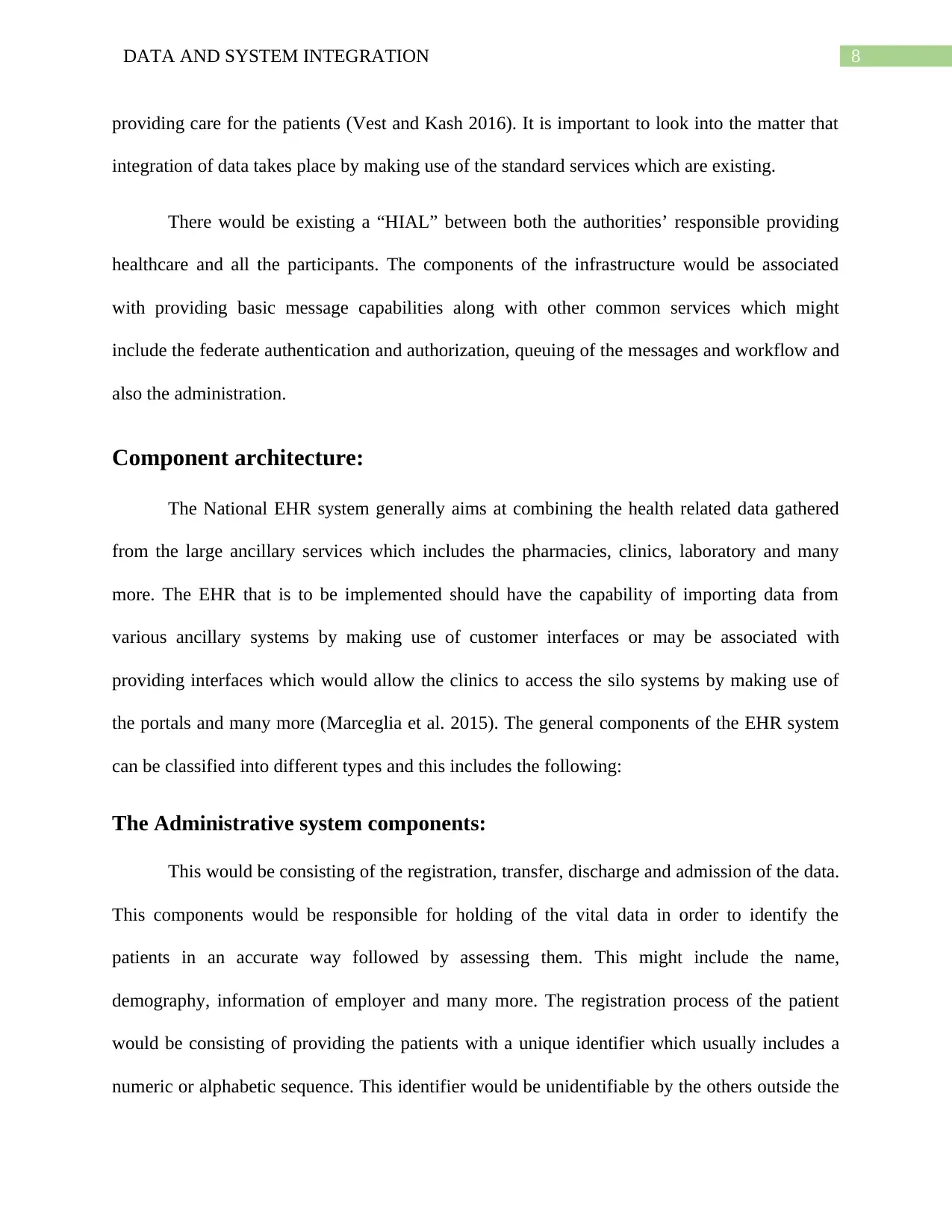
8DATA AND SYSTEM INTEGRATION
providing care for the patients (Vest and Kash 2016). It is important to look into the matter that
integration of data takes place by making use of the standard services which are existing.
There would be existing a “HIAL” between both the authorities’ responsible providing
healthcare and all the participants. The components of the infrastructure would be associated
with providing basic message capabilities along with other common services which might
include the federate authentication and authorization, queuing of the messages and workflow and
also the administration.
Component architecture:
The National EHR system generally aims at combining the health related data gathered
from the large ancillary services which includes the pharmacies, clinics, laboratory and many
more. The EHR that is to be implemented should have the capability of importing data from
various ancillary systems by making use of customer interfaces or may be associated with
providing interfaces which would allow the clinics to access the silo systems by making use of
the portals and many more (Marceglia et al. 2015). The general components of the EHR system
can be classified into different types and this includes the following:
The Administrative system components:
This would be consisting of the registration, transfer, discharge and admission of the data.
This components would be responsible for holding of the vital data in order to identify the
patients in an accurate way followed by assessing them. This might include the name,
demography, information of employer and many more. The registration process of the patient
would be consisting of providing the patients with a unique identifier which usually includes a
numeric or alphabetic sequence. This identifier would be unidentifiable by the others outside the
providing care for the patients (Vest and Kash 2016). It is important to look into the matter that
integration of data takes place by making use of the standard services which are existing.
There would be existing a “HIAL” between both the authorities’ responsible providing
healthcare and all the participants. The components of the infrastructure would be associated
with providing basic message capabilities along with other common services which might
include the federate authentication and authorization, queuing of the messages and workflow and
also the administration.
Component architecture:
The National EHR system generally aims at combining the health related data gathered
from the large ancillary services which includes the pharmacies, clinics, laboratory and many
more. The EHR that is to be implemented should have the capability of importing data from
various ancillary systems by making use of customer interfaces or may be associated with
providing interfaces which would allow the clinics to access the silo systems by making use of
the portals and many more (Marceglia et al. 2015). The general components of the EHR system
can be classified into different types and this includes the following:
The Administrative system components:
This would be consisting of the registration, transfer, discharge and admission of the data.
This components would be responsible for holding of the vital data in order to identify the
patients in an accurate way followed by assessing them. This might include the name,
demography, information of employer and many more. The registration process of the patient
would be consisting of providing the patients with a unique identifier which usually includes a
numeric or alphabetic sequence. This identifier would be unidentifiable by the others outside the
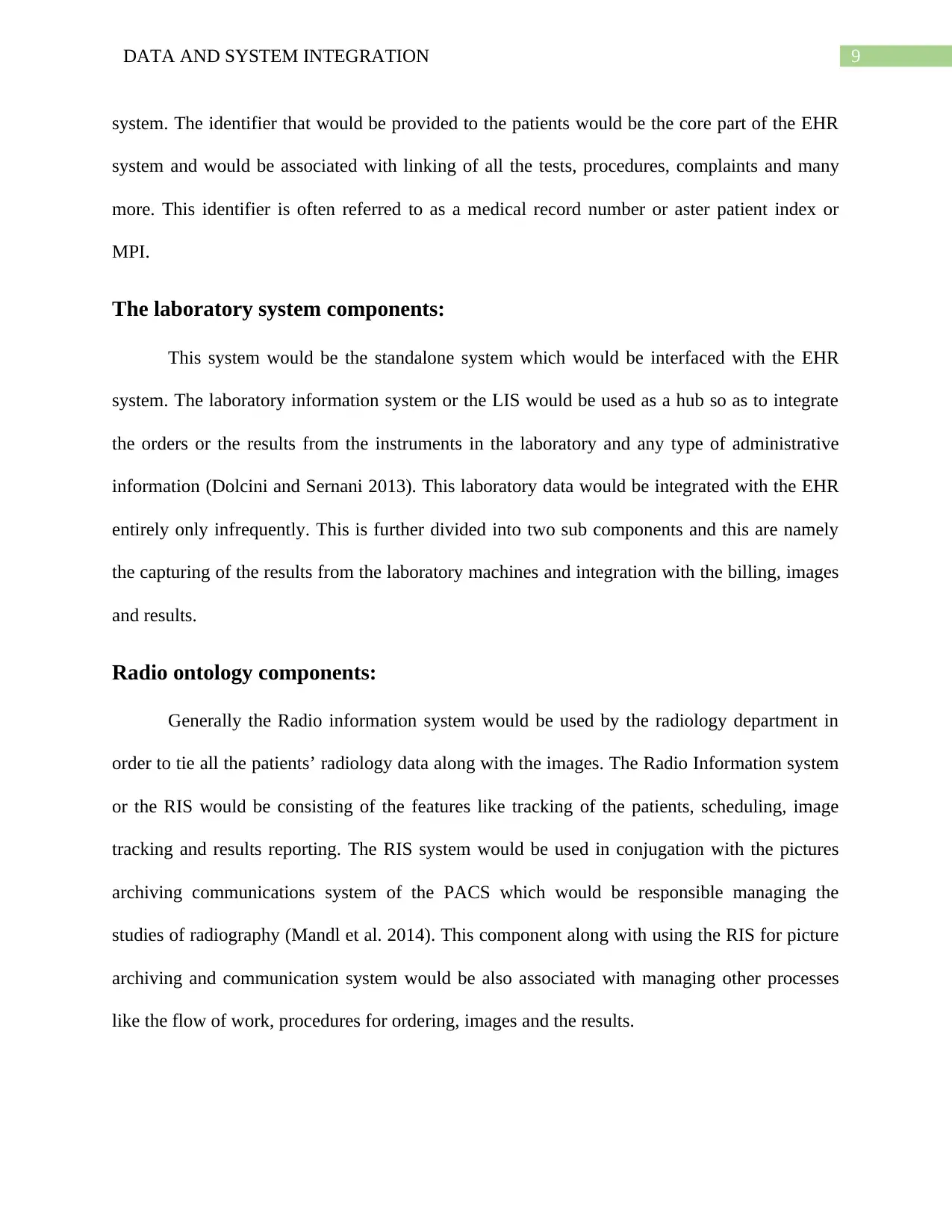
9DATA AND SYSTEM INTEGRATION
system. The identifier that would be provided to the patients would be the core part of the EHR
system and would be associated with linking of all the tests, procedures, complaints and many
more. This identifier is often referred to as a medical record number or aster patient index or
MPI.
The laboratory system components:
This system would be the standalone system which would be interfaced with the EHR
system. The laboratory information system or the LIS would be used as a hub so as to integrate
the orders or the results from the instruments in the laboratory and any type of administrative
information (Dolcini and Sernani 2013). This laboratory data would be integrated with the EHR
entirely only infrequently. This is further divided into two sub components and this are namely
the capturing of the results from the laboratory machines and integration with the billing, images
and results.
Radio ontology components:
Generally the Radio information system would be used by the radiology department in
order to tie all the patients’ radiology data along with the images. The Radio Information system
or the RIS would be consisting of the features like tracking of the patients, scheduling, image
tracking and results reporting. The RIS system would be used in conjugation with the pictures
archiving communications system of the PACS which would be responsible managing the
studies of radiography (Mandl et al. 2014). This component along with using the RIS for picture
archiving and communication system would be also associated with managing other processes
like the flow of work, procedures for ordering, images and the results.
system. The identifier that would be provided to the patients would be the core part of the EHR
system and would be associated with linking of all the tests, procedures, complaints and many
more. This identifier is often referred to as a medical record number or aster patient index or
MPI.
The laboratory system components:
This system would be the standalone system which would be interfaced with the EHR
system. The laboratory information system or the LIS would be used as a hub so as to integrate
the orders or the results from the instruments in the laboratory and any type of administrative
information (Dolcini and Sernani 2013). This laboratory data would be integrated with the EHR
entirely only infrequently. This is further divided into two sub components and this are namely
the capturing of the results from the laboratory machines and integration with the billing, images
and results.
Radio ontology components:
Generally the Radio information system would be used by the radiology department in
order to tie all the patients’ radiology data along with the images. The Radio Information system
or the RIS would be consisting of the features like tracking of the patients, scheduling, image
tracking and results reporting. The RIS system would be used in conjugation with the pictures
archiving communications system of the PACS which would be responsible managing the
studies of radiography (Mandl et al. 2014). This component along with using the RIS for picture
archiving and communication system would be also associated with managing other processes
like the flow of work, procedures for ordering, images and the results.
Secure Best Marks with AI Grader
Need help grading? Try our AI Grader for instant feedback on your assignments.
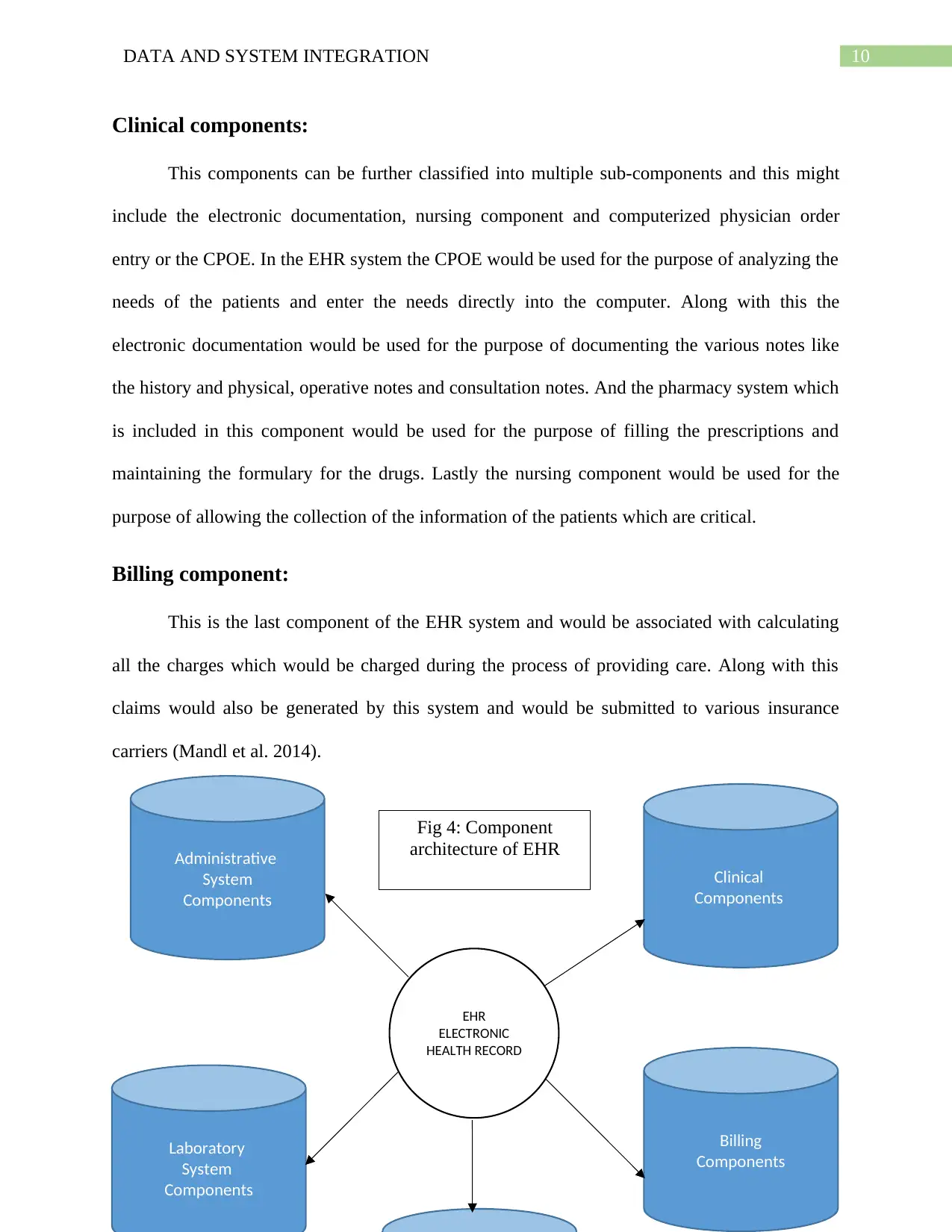
10DATA AND SYSTEM INTEGRATION
Clinical components:
This components can be further classified into multiple sub-components and this might
include the electronic documentation, nursing component and computerized physician order
entry or the CPOE. In the EHR system the CPOE would be used for the purpose of analyzing the
needs of the patients and enter the needs directly into the computer. Along with this the
electronic documentation would be used for the purpose of documenting the various notes like
the history and physical, operative notes and consultation notes. And the pharmacy system which
is included in this component would be used for the purpose of filling the prescriptions and
maintaining the formulary for the drugs. Lastly the nursing component would be used for the
purpose of allowing the collection of the information of the patients which are critical.
Billing component:
This is the last component of the EHR system and would be associated with calculating
all the charges which would be charged during the process of providing care. Along with this
claims would also be generated by this system and would be submitted to various insurance
carriers (Mandl et al. 2014).
EHR
ELECTRONIC
HEALTH RECORD
Administrative
System
Components
Laboratory
System
Components
Billing
Components
Clinical
Components
Fig 4: Component
architecture of EHR
Clinical components:
This components can be further classified into multiple sub-components and this might
include the electronic documentation, nursing component and computerized physician order
entry or the CPOE. In the EHR system the CPOE would be used for the purpose of analyzing the
needs of the patients and enter the needs directly into the computer. Along with this the
electronic documentation would be used for the purpose of documenting the various notes like
the history and physical, operative notes and consultation notes. And the pharmacy system which
is included in this component would be used for the purpose of filling the prescriptions and
maintaining the formulary for the drugs. Lastly the nursing component would be used for the
purpose of allowing the collection of the information of the patients which are critical.
Billing component:
This is the last component of the EHR system and would be associated with calculating
all the charges which would be charged during the process of providing care. Along with this
claims would also be generated by this system and would be submitted to various insurance
carriers (Mandl et al. 2014).
EHR
ELECTRONIC
HEALTH RECORD
Administrative
System
Components
Laboratory
System
Components
Billing
Components
Clinical
Components
Fig 4: Component
architecture of EHR
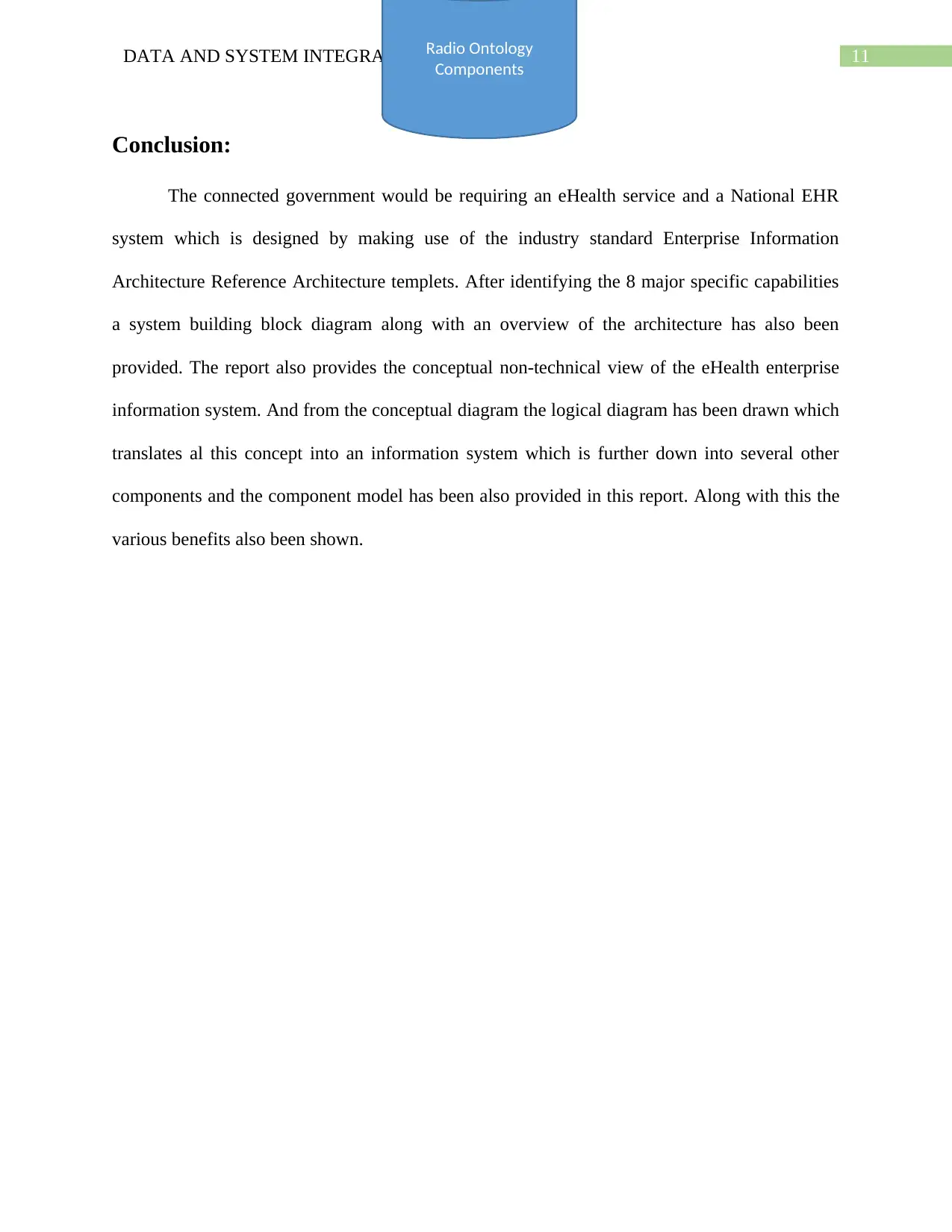
11DATA AND SYSTEM INTEGRATION
Conclusion:
The connected government would be requiring an eHealth service and a National EHR
system which is designed by making use of the industry standard Enterprise Information
Architecture Reference Architecture templets. After identifying the 8 major specific capabilities
a system building block diagram along with an overview of the architecture has also been
provided. The report also provides the conceptual non-technical view of the eHealth enterprise
information system. And from the conceptual diagram the logical diagram has been drawn which
translates al this concept into an information system which is further down into several other
components and the component model has been also provided in this report. Along with this the
various benefits also been shown.
Radio Ontology
Components
Conclusion:
The connected government would be requiring an eHealth service and a National EHR
system which is designed by making use of the industry standard Enterprise Information
Architecture Reference Architecture templets. After identifying the 8 major specific capabilities
a system building block diagram along with an overview of the architecture has also been
provided. The report also provides the conceptual non-technical view of the eHealth enterprise
information system. And from the conceptual diagram the logical diagram has been drawn which
translates al this concept into an information system which is further down into several other
components and the component model has been also provided in this report. Along with this the
various benefits also been shown.
Radio Ontology
Components
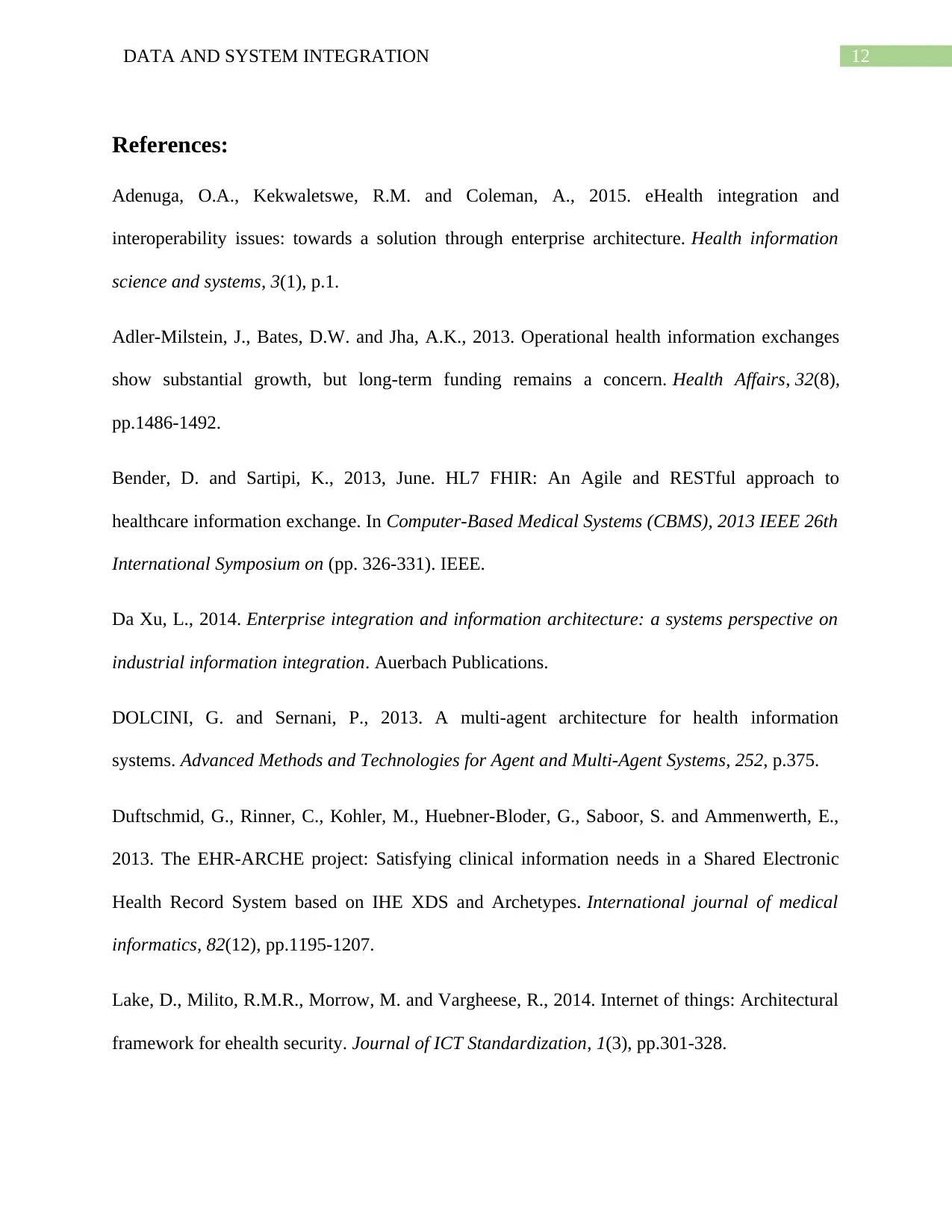
12DATA AND SYSTEM INTEGRATION
References:
Adenuga, O.A., Kekwaletswe, R.M. and Coleman, A., 2015. eHealth integration and
interoperability issues: towards a solution through enterprise architecture. Health information
science and systems, 3(1), p.1.
Adler-Milstein, J., Bates, D.W. and Jha, A.K., 2013. Operational health information exchanges
show substantial growth, but long-term funding remains a concern. Health Affairs, 32(8),
pp.1486-1492.
Bender, D. and Sartipi, K., 2013, June. HL7 FHIR: An Agile and RESTful approach to
healthcare information exchange. In Computer-Based Medical Systems (CBMS), 2013 IEEE 26th
International Symposium on (pp. 326-331). IEEE.
Da Xu, L., 2014. Enterprise integration and information architecture: a systems perspective on
industrial information integration. Auerbach Publications.
DOLCINI, G. and Sernani, P., 2013. A multi-agent architecture for health information
systems. Advanced Methods and Technologies for Agent and Multi-Agent Systems, 252, p.375.
Duftschmid, G., Rinner, C., Kohler, M., Huebner-Bloder, G., Saboor, S. and Ammenwerth, E.,
2013. The EHR-ARCHE project: Satisfying clinical information needs in a Shared Electronic
Health Record System based on IHE XDS and Archetypes. International journal of medical
informatics, 82(12), pp.1195-1207.
Lake, D., Milito, R.M.R., Morrow, M. and Vargheese, R., 2014. Internet of things: Architectural
framework for ehealth security. Journal of ICT Standardization, 1(3), pp.301-328.
References:
Adenuga, O.A., Kekwaletswe, R.M. and Coleman, A., 2015. eHealth integration and
interoperability issues: towards a solution through enterprise architecture. Health information
science and systems, 3(1), p.1.
Adler-Milstein, J., Bates, D.W. and Jha, A.K., 2013. Operational health information exchanges
show substantial growth, but long-term funding remains a concern. Health Affairs, 32(8),
pp.1486-1492.
Bender, D. and Sartipi, K., 2013, June. HL7 FHIR: An Agile and RESTful approach to
healthcare information exchange. In Computer-Based Medical Systems (CBMS), 2013 IEEE 26th
International Symposium on (pp. 326-331). IEEE.
Da Xu, L., 2014. Enterprise integration and information architecture: a systems perspective on
industrial information integration. Auerbach Publications.
DOLCINI, G. and Sernani, P., 2013. A multi-agent architecture for health information
systems. Advanced Methods and Technologies for Agent and Multi-Agent Systems, 252, p.375.
Duftschmid, G., Rinner, C., Kohler, M., Huebner-Bloder, G., Saboor, S. and Ammenwerth, E.,
2013. The EHR-ARCHE project: Satisfying clinical information needs in a Shared Electronic
Health Record System based on IHE XDS and Archetypes. International journal of medical
informatics, 82(12), pp.1195-1207.
Lake, D., Milito, R.M.R., Morrow, M. and Vargheese, R., 2014. Internet of things: Architectural
framework for ehealth security. Journal of ICT Standardization, 1(3), pp.301-328.
Paraphrase This Document
Need a fresh take? Get an instant paraphrase of this document with our AI Paraphraser
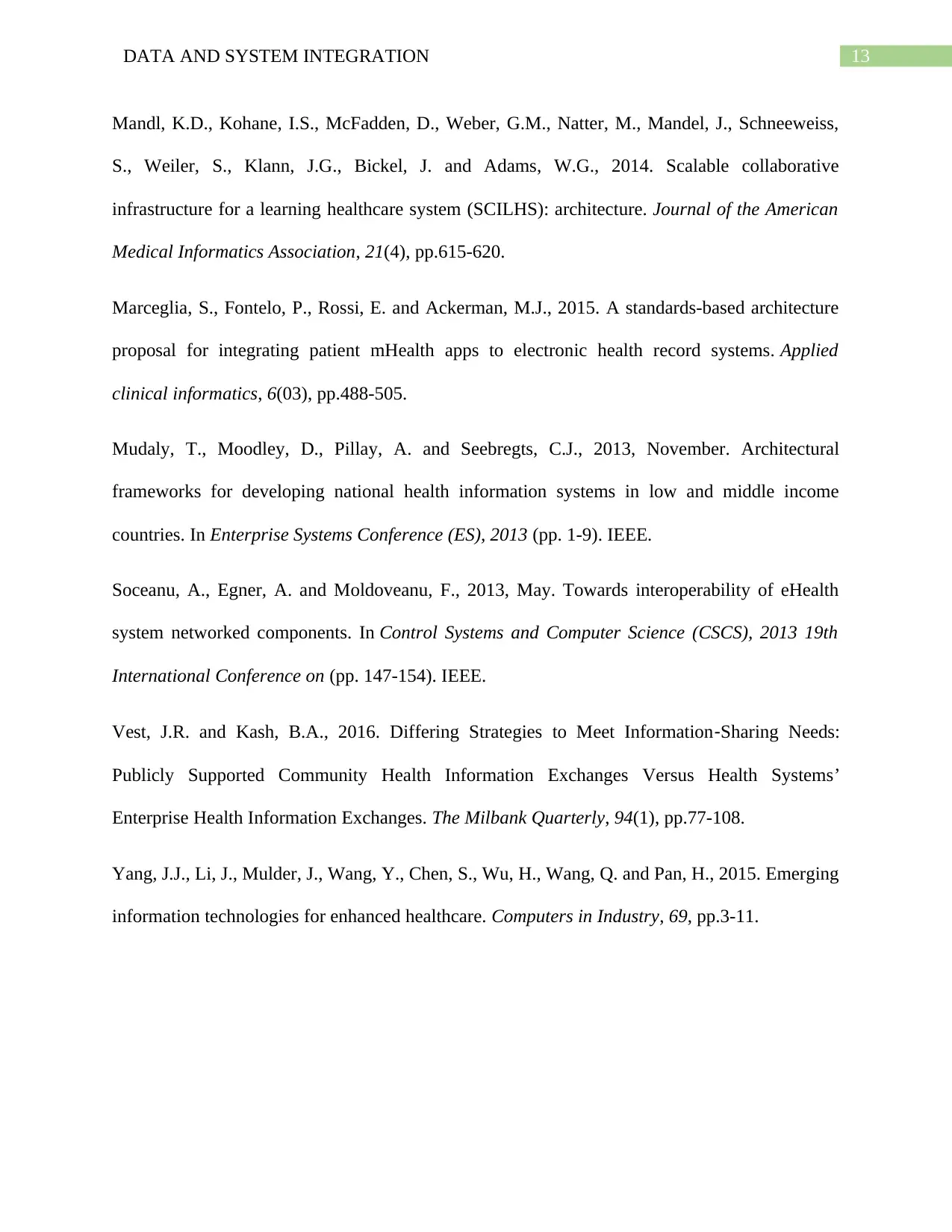
13DATA AND SYSTEM INTEGRATION
Mandl, K.D., Kohane, I.S., McFadden, D., Weber, G.M., Natter, M., Mandel, J., Schneeweiss,
S., Weiler, S., Klann, J.G., Bickel, J. and Adams, W.G., 2014. Scalable collaborative
infrastructure for a learning healthcare system (SCILHS): architecture. Journal of the American
Medical Informatics Association, 21(4), pp.615-620.
Marceglia, S., Fontelo, P., Rossi, E. and Ackerman, M.J., 2015. A standards-based architecture
proposal for integrating patient mHealth apps to electronic health record systems. Applied
clinical informatics, 6(03), pp.488-505.
Mudaly, T., Moodley, D., Pillay, A. and Seebregts, C.J., 2013, November. Architectural
frameworks for developing national health information systems in low and middle income
countries. In Enterprise Systems Conference (ES), 2013 (pp. 1-9). IEEE.
Soceanu, A., Egner, A. and Moldoveanu, F., 2013, May. Towards interoperability of eHealth
system networked components. In Control Systems and Computer Science (CSCS), 2013 19th
International Conference on (pp. 147-154). IEEE.
Vest, J.R. and Kash, B.A., 2016. Differing Strategies to Meet Information‐Sharing Needs:
Publicly Supported Community Health Information Exchanges Versus Health Systems’
Enterprise Health Information Exchanges. The Milbank Quarterly, 94(1), pp.77-108.
Yang, J.J., Li, J., Mulder, J., Wang, Y., Chen, S., Wu, H., Wang, Q. and Pan, H., 2015. Emerging
information technologies for enhanced healthcare. Computers in Industry, 69, pp.3-11.
Mandl, K.D., Kohane, I.S., McFadden, D., Weber, G.M., Natter, M., Mandel, J., Schneeweiss,
S., Weiler, S., Klann, J.G., Bickel, J. and Adams, W.G., 2014. Scalable collaborative
infrastructure for a learning healthcare system (SCILHS): architecture. Journal of the American
Medical Informatics Association, 21(4), pp.615-620.
Marceglia, S., Fontelo, P., Rossi, E. and Ackerman, M.J., 2015. A standards-based architecture
proposal for integrating patient mHealth apps to electronic health record systems. Applied
clinical informatics, 6(03), pp.488-505.
Mudaly, T., Moodley, D., Pillay, A. and Seebregts, C.J., 2013, November. Architectural
frameworks for developing national health information systems in low and middle income
countries. In Enterprise Systems Conference (ES), 2013 (pp. 1-9). IEEE.
Soceanu, A., Egner, A. and Moldoveanu, F., 2013, May. Towards interoperability of eHealth
system networked components. In Control Systems and Computer Science (CSCS), 2013 19th
International Conference on (pp. 147-154). IEEE.
Vest, J.R. and Kash, B.A., 2016. Differing Strategies to Meet Information‐Sharing Needs:
Publicly Supported Community Health Information Exchanges Versus Health Systems’
Enterprise Health Information Exchanges. The Milbank Quarterly, 94(1), pp.77-108.
Yang, J.J., Li, J., Mulder, J., Wang, Y., Chen, S., Wu, H., Wang, Q. and Pan, H., 2015. Emerging
information technologies for enhanced healthcare. Computers in Industry, 69, pp.3-11.
1 out of 14
Related Documents
Your All-in-One AI-Powered Toolkit for Academic Success.
+13062052269
info@desklib.com
Available 24*7 on WhatsApp / Email
![[object Object]](/_next/static/media/star-bottom.7253800d.svg)
Unlock your academic potential
© 2024 | Zucol Services PVT LTD | All rights reserved.




